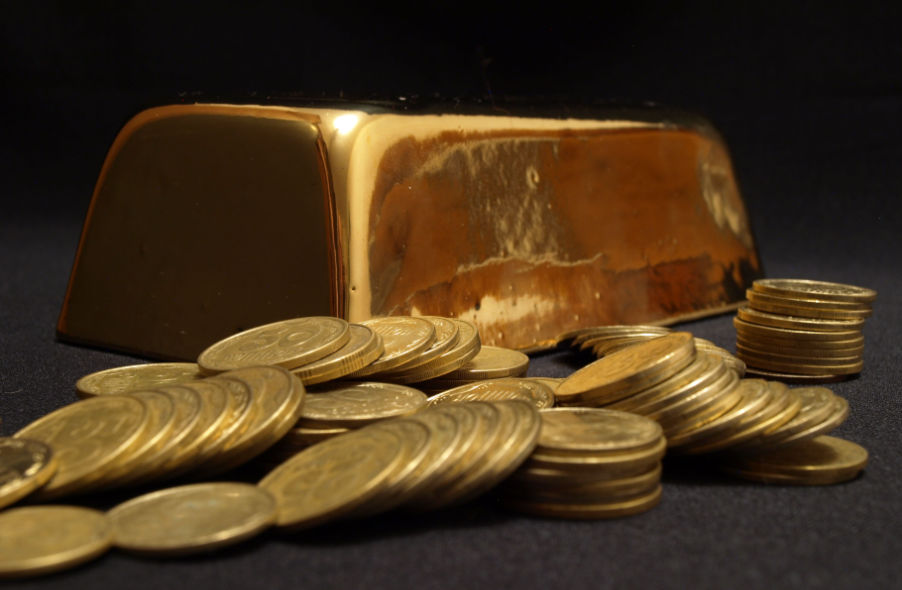Gold is a desirable investment product for many reasons — it can diversify your portfolio, act as an inflation hedge, mitigate risk, and more.
But buying physical gold isn’t the only way to invest in this commodity. More and more investors have begun opening gold IRAs in addition to or in place of their physical gold investments.
Physical gold and gold IRAs offer different benefits and disadvantages, and understanding the ins and outs of each can help you make more informed investment decisions. Read on to learn everything you need to know about investing in a gold IRA vs. physical gold.
What is a Gold IRA?
A gold IRA is a type of individual retirement account. The two main types of IRAs are a traditional IRA and a Roth IRA. Gold IRAs are a form of traditional IRA known as a “self-directed IRA.”
When you invest in a traditional IRA, your IRA broker will take the money you contribute and invest it in stocks, bonds, or mutual funds. However, when you invest in a self-directed IRA, you’ll have the option to invest in alternative assets, such as precious metals.
Gold individual retirement accounts can hold gold, silver, platinum, and palladium. Alternatively, you can invest in a gold ETF, a gold mining company, or gold futures with your self-directed IRA.
These retirement accounts can enable you to diversify your investment portfolio outside of the typical mutual funds and gain the benefits of investing in precious metals without needing to store the physical gold yourself.
What is Physical Gold?

Physical gold is just what it sounds like — real, physical gold products. You can buy physical gold from a few different places:
- Gold dealers, pawn shops, and rare coin stores
- Individuals
- Gold websites
You can also buy physical gold in several forms:
- Collectible gold coins
- Gold bullion coins
- Gold bullion bars
- Gold jewelry and decor
If you’re looking to buy gold as an investment, collectible coins and bullion are your best options. Gold coins hold value because of their rare, collectible faces, and this value can fluctuate over time. Meanwhile, gold bullion (including gold bars, rounds, and non-collectible coins) comes from private mints and refineries.
Difference Between Gold IRA and Physical Gold
Physical gold and gold IRAs are two of the most popular gold investing options. Understanding the differences between these two can help you choose the right option for your investment portfolio.
Here are the most significant differences between a gold IRA vs. physical gold:
Storage
When you invest in a gold IRA, you cannot take physical possession of the precious metals in your account. Instead, you’ll need to choose a depository to store your gold investments.
Many gold IRA custodians have at least one or two depositories they work with to store the physical gold their clients hold in their IRAs. You can choose one of these depositories or do your own research to find the best storage facility.
Meanwhile, when you purchase gold, you have total control over your storage. You can store the gold in a depository, keep it in a safe in your basement, lock it in a safe deposit box at the bank, or bury it in your backyard.
However, with great power comes great responsibility. When you invest in real gold, you’ll be responsible for it and reap the consequences if it becomes damaged, lost, or stolen. Many people who invest in physical precious metals choose to store their products in vaults for safety reasons.
Security

Storage and security go hand in hand. When you store your gold and precious metals in a certified depository, you can trust that they will be safe from theft and natural disasters — and if they aren’t, you can receive their insured value.
Gold depositories are specialized storage centers with a range of features to keep your precious metals safe. These storage facilities include:
- Provide round-the-clock, armed security
- Have high-quality cameras running at all times
- Use temperature-controlled facilities to keep gold safe and preserved
You can choose segregated storage to keep your gold separate from other customers’ precious metals or opt for commingled storage to save money.
In general, investing in a gold IRA may be safer than buying actual gold and storing it. But if you keep your gold in a depository, it will be just as safe as it is within your self-directed gold IRA, as this gold is also stored in a depository.
Additional Fees
Investing in gold IRAs vs. physical gold comes with varying fees.
When you open a gold IRA, your custodian may charge you a few different fees, such as:
- A one-time account setup fee (typically between $50 and $150)
- Annual brokerage fees (typically between $50 and $150)
- Storage fees, which you pay directly to the storage facility or your custodian pays on your behalf
Your IRA custodian should disclose your fees before you invest in your retirement account.
Meanwhile, when you buy gold directly, you won’t have to pay any initial fees on top of your purchase price. Your only costs come from your storage option. If you choose to keep your gold at home, your investment may be entirely free of fees.
Tax Implications
Precious metal IRAs and physical gold have different tax implications and tax advantages.
Whether you create a Roth gold IRA or a traditional gold IRA, your taxes will follow the tax laws for that retirement account type. These accounts enable you to grow your assets without needing to pay taxes. Traditional IRAs use pre-tax dollars, while Roth IRAs use post-tax dollars.
In both cases, gains accrue tax-free. However, with a traditional IRA (as are many self-directed gold IRAs), you can defer paying taxes until you withdraw your retirement funds.
Meanwhile, investing in real gold has fewer tax benefits. The IRS taxes gold as a collectible, using the capital gains tax rate. This rate is no higher than 28%.
You must also meet IRS reporting requirements when you sell precious metals. For instance, you’ll probably need to file Form 1099-B with your taxes to report gold transactions. Understanding the IRS reporting requirements is essential to being a responsible investor.
Gold IRAs are exempt from the capital gains tax rate and are only subject to the rate for taxable income.
Funding Methods

Most gold IRA custodians will require you to fund your new IRA through an IRA rollover. This means you cannot give them cash to buy the gold in your gold IRA. Instead, you’ll need to transfer the funds from an existing traditional or Roth IRA through a process known as gold IRA rollovers.
Meanwhile, you can pay for actual gold with cash, check, or whatever payment method your merchant accepts. You also don’t need to wait for an IRA rollover to process — you can go out today and purchase gold to add to your portfolio.
Contribution Limits
When you invest in a gold IRA, you must stick to the same contribution limits as are present for traditional IRAs. While these limits can vary, in 2022, they were $6,500 per year, with an additional $1,000 available for gold IRA investors 50 and older.
In contrast, there is no limit on the amount of actual gold you can buy in one year. While some experts recommend not investing more than 5% to 10% of your portfolio in gold, the choice is up to you.
Types of Products Available
When you invest in physical precious metals, you can choose any level of purity you desire. If you have a lower budget, you may choose less pure gold. You can also choose between gold coins, gold bullion, gold bars, and other versatile gold products.
Meanwhile, when you invest in a gold IRA, you can only choose from gold products that are at least 99.5% pure. This qualifier encompasses certain types of gold coins and most gold bullion and gold bar products.
Investment Options for Physical Gold

When purchasing gold as an investment, your options are endless. You can buy any type of gold product you desire, hold it for as long as you’d like, and sell it when you’re ready. However, your taxes will vary depending on how long you hold the gold.
When you hold your gold for less than a year, your sale will be subject to short-term capital gains tax. Holding physical gold for more than a year subjects it to long-term capital gains.
There are a few different types of gold products you can invest in for your retirement portfolio. These include:
- Physical gold coins
- Gold rounds
- Gold bars
- Collectible gold coins
You can also purchase items that have a small gold content, such as jewelry, art, and decor.
While you can invest in gold of any purity level, understanding the purity notations can help you determine whether a gold product is a smart investment.
You’ve probably heard gold referred to in terms of its “carats.” Carat notations are as follows:
- 24 carat: 100% pure gold
- 18 carat: 75% purity
- 14 carat: 58.3% purity
- 10 carat: 1.7% purity
In the U.S., 10 carats is the minimum accepted standard of caratage.
When you look for a gold investment, we recommend searching for products with a purity of at least 99%. You’ll have an easier time selling these gold products, and they’re much more valuable than lower-carat options.
Types Of Gold You Can Put on Your Gold IRA
Self-directed gold IRAs must meet specific standards beyond those of physical gold investing. First, the IRS requires that gold IRAs go through gold custodians. As we mentioned, you can’t hold or store your gold yourself — you need a custodian to hold it for you.
The IRS also regulates the types of gold you can include in a gold IRA. You must choose products that have a purity of at least 99.5%.
IRA-eligible gold products can include certain collectible gold coins, such as:
- American Buffalo coins
- Australian Kangaroo coins
American Eagle coins are the only exception to this rule. These coins are 91.67% but are eligible as IRA gold holdings.
Outside of collectible coins, you’ll need to check a gold product’s purity before adding it to your gold IRA account.
Many gold IRA companies take the guesswork out of choosing gold products to hold in your IRA. They’ll only let you select eligible products, then add them to your account and store them for you.
Advantages of Investing in Physical Gold and a Gold IRA

Owning gold and investing in a gold IRA offer different benefits. Here are the advantages of both investment options:
Pros of gold IRAs:
- Can include any approved precious metals, such as silver coins, platinum, and palladium
- Use custodians to take the work out of storing and managing your gold investment
- Do not face capital gains taxes and provide some tax advantages
- Can directly fund your retirement portfolio
Pros of physical gold:
- Give you immediate access to your physical gold coins and other products
- Allow more control over your gold investment
- Have no distribution or cash-out requirements
Do They Have The Same Risk?
Gold IRAs and physical gold have similar risks in terms of market value. When the price of gold fluctuates, the value of your investment will change.
However, storing gold creates its own risks. Attempting to keep your precious metal investment at home places you at risk of losing the entire investment. Your investment is subject to theft, fire, and misplacement.
Minimum Investment
Gold IRAs and physical gold also have different minimum investment requirements:
Gold IRA
While the IRS does not have a minimum investment amount for gold IRAs, most custodians have their own minimum amounts — typically at least $10,000.
Physical Gold
There is no minimum investment amount for physical metal products. If you have only a few hundred dollars to spare, you can purchase a small amount of gold and slowly add to your investment over time.
How Much Gold Can You Invest in a Gold IRA?

The IRS limits the amount you can invest in a gold IRA each year. In 2023, this limit is $6,500. If you are 50 or older, you can contribute an additional $1,000 annually to this limit.
How Much Physical Gold Can You Own?
You can own as much physical gold as you can afford. There are no rules or restrictions for gold ownership in the U.S.
Physical Gold and Gold IRA: Which Is Right for You?
Now that you know the main differences between investing in a gold IRA and purchasing real gold, you can consider which investment option is right for you.
Who Should Invest in Physical Gold?
Owning physical gold may be the right choice for people who:
- Want complete control over their precious metal investment
- Want more investment options (including gold with lower purity)
- Do not want to be subject to IRA rules
- Do not desire the tax benefits of IRAs
Who Should Invest in Gold IRA?
Investing in a gold IRA may be the better option for people who:
- Want a hands-off approach to gold investing
- Want to take advantage of IRA tax benefits and tax deductions
- Do not want to be responsible for storing and owning gold
- Don’t mind paying fees in exchange for the added security of their IRA investment
If you’re still unsure, browse our articles on Learn About Gold to understand the ins and outs of investing in gold.





